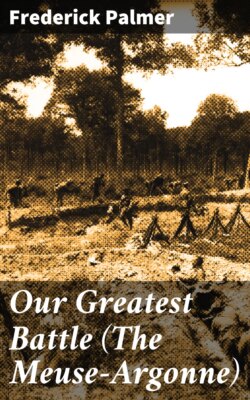Our Greatest Battle (The Meuse-Argonne)

Реклама. ООО «ЛитРес», ИНН: 7719571260.
Оглавление
Frederick Palmer. Our Greatest Battle (The Meuse-Argonne)
Our Greatest Battle (The Meuse-Argonne)
Table of Contents
TABLE OF MAPS
I. A CHANGE OF PLAN
II. INTO LINE FOR ATTACK
III. NEW AND OLD DIVISIONS
IV. THE ORDER OF BATTLE
V. ON THE MEUSE SIDE
VI
VII. IN THE WAKE OF THE INFANTRY
VIII. THE FIRST DAY
IX. THE ATTACK SLOWS DOWN
X. BY THE RIGHT FLANK
XI. BY THE LEFT
XII. BY THE CENTER
XIII. OVER THE HINDENBURG LINE
XIV. DISENGAGING RHEIMS
XV. VETERANS DRIVE A WEDGE
XVI. MASTERING THE AIRE TROUGH
XVII. VETERANS CONTINUE DRIVING
XVIII. THE GRANDPRÉ GAP IS OURS
XIX. ANOTHER WEDGE
XX. IN THE MEUSE TROUGH
XXI. SOME CHANGES IN COMMAND
XXII. A CALL FOR HARBORD
XXIII. THE S. O. S. DRIVES A WEDGE
XXIV. REGULARS AND RESERVES
XXV. LEAVENWORTH COMMANDS
XXVI. OTHERS OBEY
XXVII. AMERICAN MANHOOD
XXVIII. THE MILL OF BATTLE
XXIX. THEY ALSO SERVED
XXX. THROUGH THE KRIEMHILDE
XXXI. A CITADEL AND A BOWL
XXXII. THE FINAL ATTACK
XXXIII. VICTORY
INDEX
Отрывок из книги
Frederick Palmer
Published by Good Press, 2019
.....
The 33rd Division, remaining at the British front after the other divisions had departed, gained experience in offensive operations, as we know, which approximated that of the others at Château-Thierry, when, fighting in the inspiring company of the Australians in the Somme attacks beginning August 8th, the Illinois men took vital positions and numerous prisoners and guns. Though these four divisions, the 4th, 28th, 33rd, and 77th, had not had the long experience of the four pioneer divisions, they had had their "baptism of fire" under severe conditions, they knew German machine-gun methods from close contact, and they had the conviction of their power from having seen the enemy yield before their determined attacks. To Marshal Foch they had brought further evidence that the character of the pioneer divisions with their long training in France was common to all American troops. The National Guard divisions which had arrived late in France, though they had been filled with recruits, had, as the background of their training camp experience at home, not only the established inheritance of their organization but the thankless and instructive service on the Mexican border, where for many months they had been on a war footing.
According to European standards none of the divisions in the first shock of the Meuse-Argonne battle was veteran, of course; and the mission given them would have been considered beyond their powers. Indeed, the disaster of broken units, dispersing from lack of tactical skill, once they were against the fortifications, would have been considered inevitable. A veteran or "shock" division in the European sense—such divisions as the European armies used for major attacks and difficult operations—would have had a superior record in four years of war. Its survivors, through absorption no less than training, would have developed a craft which was now instinctive. They were Europeans fighting in Europe; they knew their enemy and how he would act in given emergencies; they knew the signs which showed that he was weakening or that he was going to resist sturdily; they knew how to find dead spaces, and how to avoid fire; and they had developed that sense of team-play which adjusts itself automatically to situations. All that our divisions knew of these things they had learned from schooling or in one or two battles. We had the advantage that experience had not hardened our initiative until we might be overcautious on some occasions.
.....